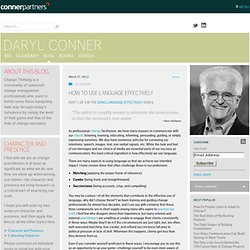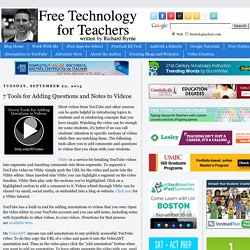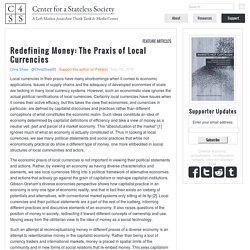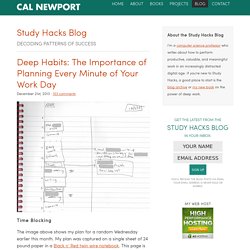

JSNNDRMDRFKR
Maths Resources. Encyclopedia of Life. Technology & learning. Logic. How to Use Language Effectively. “The ability to simplify means to eliminate the unnecessary so that the necessary may speak. ” —Hans Hofmann As professional change facilitators, we have many reasons to communicate with our clients: listening, learning, educating, informing, persuading, guiding, or simply expressing ourselves.

We also have numerous vehicles for conveying our intentions: speech, images, text, non-verbal signals, etc. While the look and feel of our messages and our choice of media are essential parts of our success as communicators, the most critical ingredient is how effectively we use language. There are many aspects to using language so that we achieve our intended impact. I have chosen three that often challenge those in our profession: Matching (applying the proper frame of reference)Candor (being frank and straightforward)Succinctness (being accurate, crisp, and compelling) You may be curious—of all the elements that contribute to the effective use of language, why did I choose these? Scratch - Imagine, Program, Share. 7 Tools for Adding Questions and Notes to Videos. Short videos from YouTube and other sources can be quite helpful in introducing topics to students and or reinforcing concepts that you have taught.

Watching the video can be enough for some students, it's better if we can call students' attention to specific sections of videos while they are watching them. The following tools allow you to add comments and questions to videos that you share with your students. Vibby is a service for breaking YouTube videos into segments and inserting comments into those segments. To segment a YouTube video on Vibby simply grab the URL for the video and paste into the Vibby editor. Once inserted into Vibby you can highlight a segment on the video timeline. YouTube has a built-in tool for adding annotations to videos that you own. On VideoANT anyone can add annotations to any publicly accessible YouTube video. VideoNotes is a neat tool for taking notes while watching videos. Collaborative Tools. Skip to main content Create interactive lessons using any digital content including wikis with our free sister product TES Teach.

Get it on the web or iPad! Guest Join | Help | Sign In cooltoolsforschools Home guest| Join | Help | Sign In Home Presentation Tools. Redefining Money: The Praxis of Local Currencies. Local currencies in their praxis have many shortcomings when it comes to economic applications.

Issues of supply chains and the adequacy of developed economies of scale are lacking in many local currency systems. However, such an economistic view ignores the actual political ramifications of local currencies. Certainly local currencies have issues when it comes their active efficacy, but this takes the view that economies, and currencies in particular, are defined by capitalist discourses and practices rather than different conceptions of what constitutes the economic realm.
Such ideas constitute an idea of economy determined by capitalist definitions of efficiency and take a view of money as a neutral veil, part and parcel of a market economy. This “absolutization of the market” [1] ignores much of what an economy is actually constituted of. The economic praxis of local currencies is not important in viewing their political statements and actions. Notes: 1. WiseMapping - Visual Thinking Evolution. Free Simulation and Modeling in your Browser. Systems Thinking. Tools & Tips. Systems. Structure. Strategy & Thinking. Self Improvement. Deep Habits: The Importance of Planning Every Minute of Your Work Day. December 21st, 2013 · 153 comments Time Blocking The image above shows my plan for a random Wednesday earlier this month.

My plan was captured on a single sheet of 24 pound paper in a Black n’ Red twin wire notebook. This page is divided into two columns. In the left column, I dedicated two lines to each hour of the day and then divided that time into blocks labeled with specific assignments. Notice that I leave some extra room next to my time blocks. I call this planning method time blocking. This type of planning, to me, is like a chess game, with blocks of work getting spread and sorted in such a way that projects big and small all seem to click into completion with (just enough) time to spare. Three Concerns Sometimes people ask why I bother with such a detailed level of planning. Sometimes people ask how time blocking can work for reactive work, where you cannot tell in advance what obligations will enter your life on a given day. Conclusion. How To Stop Being Lazy And Get More Done - 5 Expert Tips.
Before we commence with the festivities, I wanted to thank everyone for helping my first book become a Wall Street Journal bestseller. To check it out, click here. Some days the to-do list seems bottomless. Just looking at it is exhausting. We all want to know how to stop being lazy and get more done. I certainly want the answer. So I decided to call a friend who manages to do this — and more. Cal Newport impresses the heck out of me. He has a full-time job as a professor at Georgetown University, teaching classes and meeting with students.He writes 6 (or more) peer-reviewed academic journal papers per year.He’s the author of 4 books including the wonderful “So Good They Can’t Ignore You.”
Work.